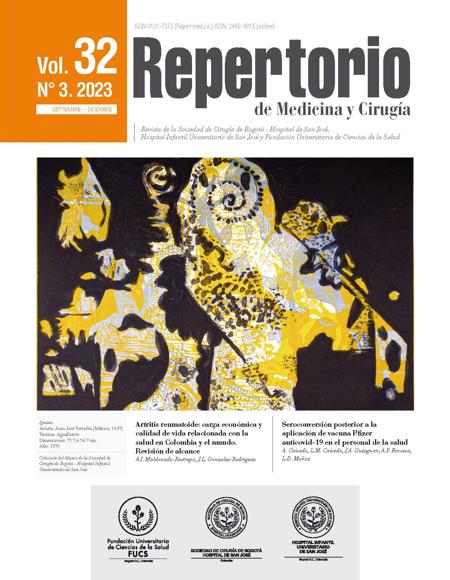Acerca de las reacciones hemolíticas tardías
About delayed hemolytic transfusion reactions
Cómo citar
Descargar cita
Esta obra está bajo una licencia internacional Creative Commons Atribución-NoComercial-CompartirIgual 4.0.
Mostrar biografía de los autores
Introducción: las reacciones hemolíticas tardías transfusionales ocurren después de 24 horas de practicadas, algunas durante las dos semanas siguientes a la transfusión o hasta en un período de 30 días. Las reacciones transfusionales inmunológicas pueden ser febriles, anafilácticas y hemolíticas. En este último nivel se presentan como reacción a antígenos de eritrocitos extraños en pacientes que fueron expuestos previamente a transfusiones y embarazo. Reporte de caso: a continuación revisaremos el caso de una paciente en el Hospital de San José de Bogotá quien presentó una reacción hemolítica tardía y se documentó la expresión de antígenos Duffy y antígenos E, secundarios a inmunización por trasfusiones anteriores.
Visitas del artículo 4441 | Visitas PDF 3815
Descargas
- Bashawri LA, Ahmed MS, El-Fawaz N, AL-Qatary AA, Ali Ahmed M. Red Cell Alloimmunization in Thalassaemia Patients Bahrain Medical Bulletin. 2005;27(2):1-6.
- Rosse WF, Gallagher D, Kinney TR, Castro O, Dosik H, Moohr J, et al. Transfusion and alloimmunization in sickle cell disease. The Cooperative Study of Sickle Cell Disease. Blood. 1990;76(7):1431-7. DOI: https://doi.org/10.1182/blood.V76.7.1431.bloodjournal7671431
- Brand A. Immunological complications of blood transfusions. Presse Med. 2016;45(7-8 Pt 2):e313-24. https://doi.org/10.1016/j.lpm.2016.06.024. DOI: https://doi.org/10.1016/j.lpm.2016.06.024
- Technical Manual. 15 ed. United States: the AABB; 2005.
- Bryant NJ. An Introduction to Immunohematology. 3 ed. Philadelphia: W.B. Saunders Company; 1994.
- Linares G. Inmunohematología y Banco de Sangre. Inmunohematologia y transfusion: principios y procedimientos Venezuela: Cromotip; 1986.
- International Society of Blood Transfusion. Blood Group Alleles. Names for RH (ISBT 004) Whorshop 2010 [Internet]. Amsterdam: International Society of Blood Transfusion; 2010 [cited 2020 febrero]; Available from: http://www.isbtweb.org/working-parties/red-cell-immunogenetics-and-bloodgroup-terminology/blood-group-terminology/blood-group-allele-terminology/.
- Vásquez Rojas M, Castillo Espinosa D, Pavez Espinoza Y, Maldonado Rojas M, Mena Leiva A. Frecuencia de antígenos del sistema sanguíneo Rh y del sistema Kell en donantes de sangre. Rev Cubana Hematol Inmunol Hemoter. 2015;31(2):160-71.
- Sanz J, Besses C, Vives J. Hematología clínica. 5 ed. España: Elsevier; 2006.
- Flegel WA. The genetics of the Rhesus blood group system. Blood Transfus.sangue. 2007;5(2):50-7. https://doi.org/10.2450/2007.0011-07.
- Daniels G, Reid ME. Blood groups: the past 50 years. Transfusion. 2010;50(2):281-9. https://doi.org/10.1111/j.1537-2995.2009.02456.x. DOI: https://doi.org/10.1111/j.1537-2995.2009.02456.x
- Dean L. The Duffy blood group. In: Dean L, editor. Blood Groups and Red Cell Antigens. United State: NCBI Bookshelf; 2005.
- Łukasik E, Nowak I, Czerwinski M, Waśniowska K. Duffy blood group system – the frequency of Duffy antigen polymorphisms and novel mutations in the Polish population. Transfus Apheresis Science. 2019;58(2):156-161. https://doi.org/10.1016/j.transci.2018.12.020. DOI: https://doi.org/10.1016/j.transci.2018.12.020
- Neote K, Mak JY, Kolakowski LF, Jr., Schall TJ. Functional and biochemical analysis of the cloned Duffy antigen: identity with the red blood cell chemokine receptor. Blood. 1994;84(1):44-52. https://doi.org/10.1182/blood.V84.1.44.44 DOI: https://doi.org/10.1182/blood.V84.1.44.bloodjournal84144













